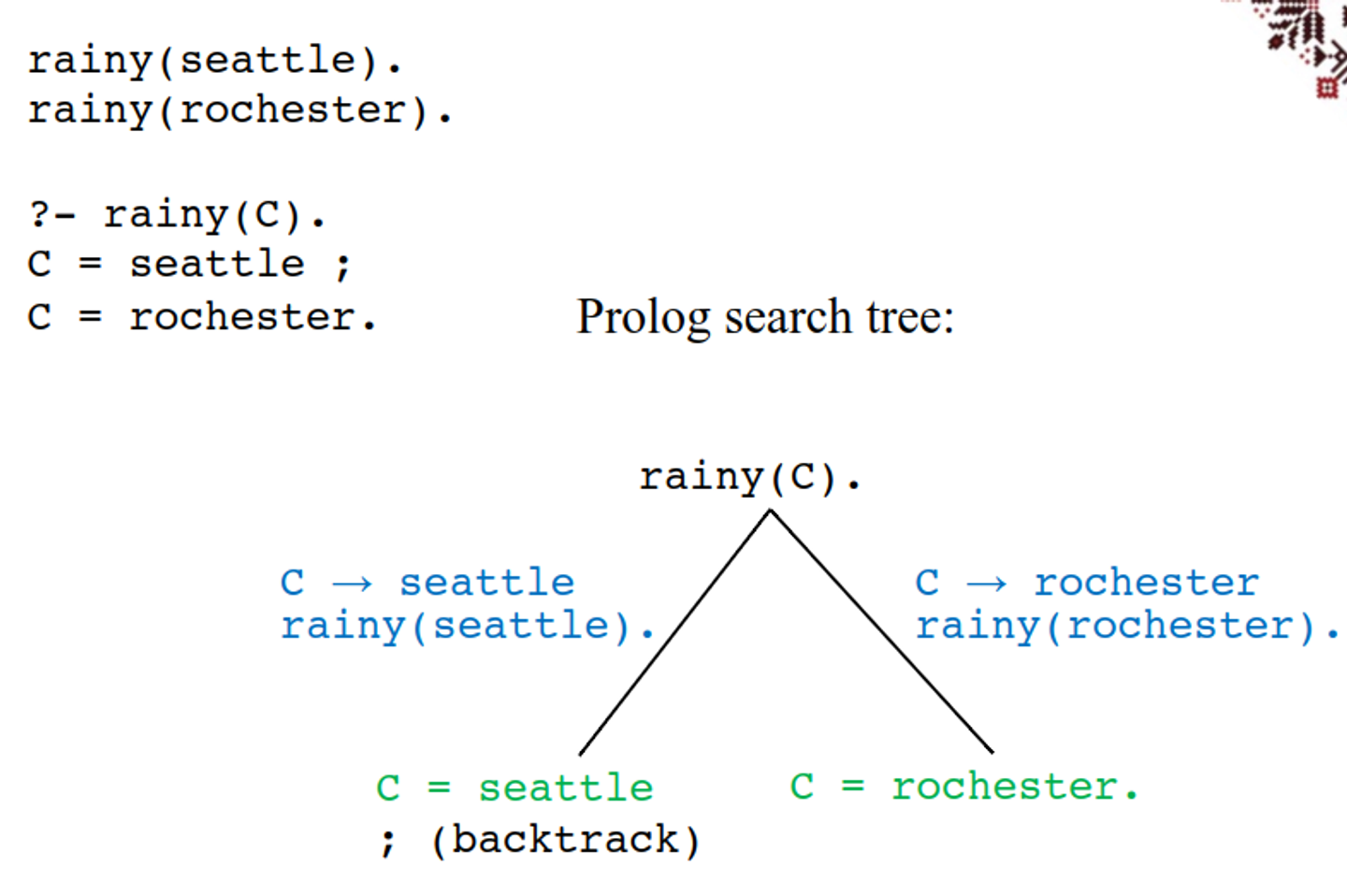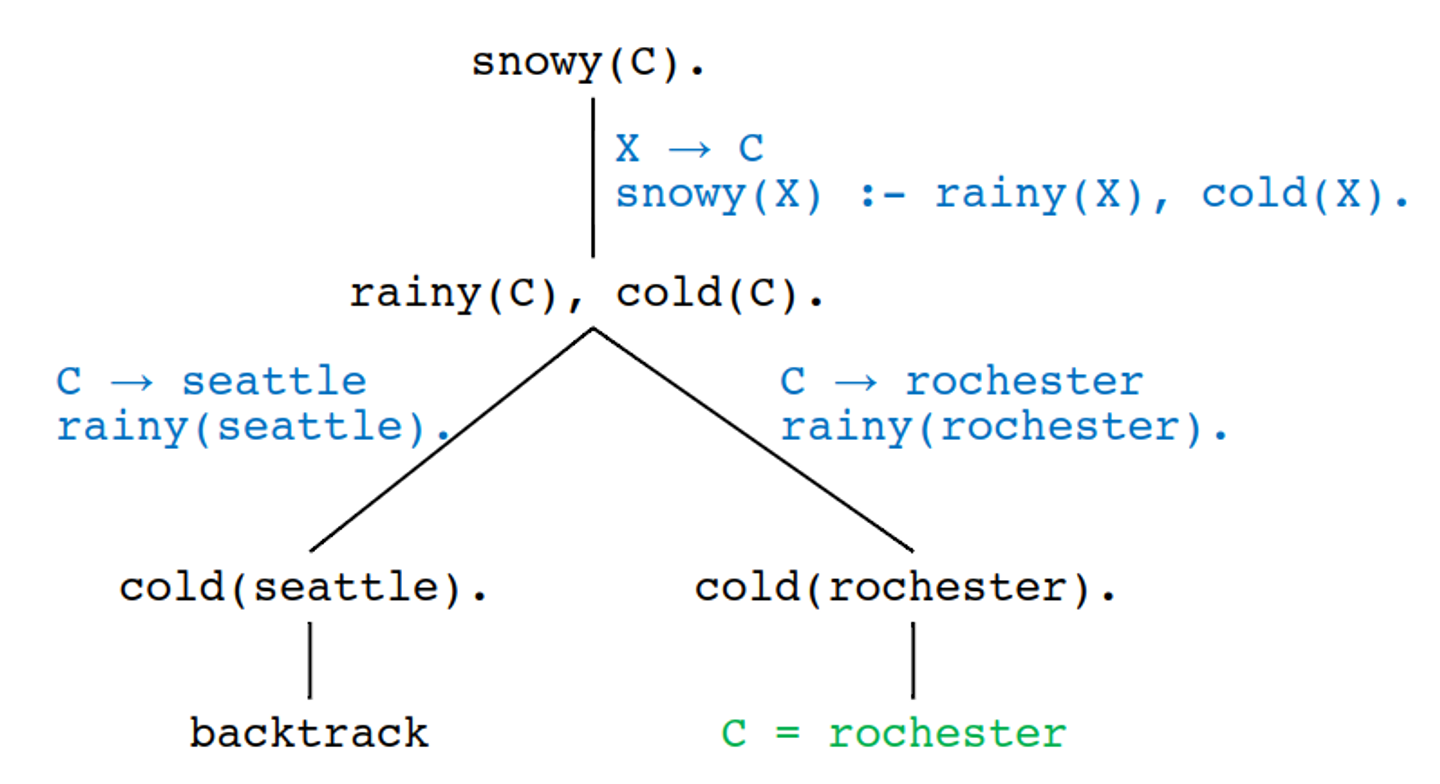Logic Programming
With logic programming, we take some axioms and compute deductions on them in order to prove some theorem
-
Axioms = Horn clauses Q₁ ∧ Q₂ ∧ … ∧ Qₖ → P or P ← Q₁ ∧ Q₂ ∧ … ∧ Qₖ
- P is the head
-
Q₁ ∧ Q₂ ∧ … ∧ Qₖ is the body
- k ≥ 1: rule: if Q₁ and Q₂ and … and Qₖ, then P
-
k = 0: fact: P (also: if true, then P)
- The meaning is that if all Qᵢ’s are true, then we can deduce P
Prolog
Prolog is an imperative language running in the context of a database with some predefined clauses
These clauses are composed of terms
- constants:
- atoms: id that starts with lower case:
foo,a,john - numbers: 0, 2022
- atoms: id that starts with lower case:
-
variables: id that starts with upper case:
Foo,X - structures: functor (atom) and argument list (terms)
student(john),takes(X, cs3342)- arguments can be constants, variables, (nested) structures
We can then recreate our logic stuff in this new language as such
term → atom | number | variable | struct
terms → term | term , terms
struct → atom ( terms )
fact → term .
rule → term :- terms .
query → ?- terms .
- Rule:
P ← Q₁ ∧ Q₂ ∧ … ∧ Qₖ
- in Prolog:
P :- Q1, Q2, ..., Qk.
- in Prolog:
- Fact (rule without right-hand side):
P (P ← true)
- in Prolog:
P.
- in Prolog:
- Query (rule without left-hand side)
Q₁ ∧ Q₂ ∧ … ∧ Qₖ
- in Prolog:
?- Q1, Q2, ..., Qk.
- in Prolog:
- the negated query is also: ```prolog false ← Q₁ ∧ Q₂ ∧ … ∧ Qₖ
These rules are implicitly universally quantified so you don’t need to add $\forall$ each time
- Example:
path(L, M) :- link(L, X), path(X, M).means:
∀L,∀M,∀X (path(L, M) if (link(L, X) and path(X, M)))or
∀L,∀M (path(L, M) if (∃X (link(L, X) and path(X, M))))
Queries are also implicitly existentially qualified
- Example:
?- path(algol60, X), path(X, c).means
∃X (path(algol60, X) and path(X, c))
To start a program, we can import some predefined clauses by setting a working directory and consulting a file
- Setting up working directory
- Checking working directory:
?- working_directory(X, X). X = (//). - Changing working directory:
?- working_directory(_, '/Users/Lucian/Documents/4_myCourses/2021-2022/CS3342b_win2022/my_programs/Prolog'). true. ?- working_directory(X, X). X = (_,'/Users/Lucian/Documents/4_myCourses/2021-2022/CS3342b_win2022/my_programs/Prolog').
- Checking working directory:
- Facts and rules from a file:
- reading the file
my_file.pl - must be in the working directory
?- consult(my_file). true.
- reading the file
From here, we can work with the file in the interpreter
- Example:
rainy(seattle). rainy(rochester). ?- rainy(C). C = seattle- Type ENTER if done
- Type
;if you want more solutions
C = seattle ; C = rochester. - Example:
rainy(seattle). rainy(rochester). cold(rochester). snowy(X) :- rainy(X), cold(X). ?- snowy(C). C = rochester.
only one solution
Lists
Much like Scheme, Prolog has its own way of implementing lists through a head and a tail
Here is the entire content in one markdown code block:
[a, b, c]– list[]– empty list- can use a
cons-like predicate:'[|]'(a, '[|]'(b, '[|]'(c, [])))means
[a, b, c] Head | Tailnotation:[H|T][a, b, c]can be written as:[a | [b, c]] [a, b | [c]] [a, b, c | []]
?- [H|T] = [a, b, c].
H = a,
T = [b, c].
?- [H|T] = [[], c | [[a], b, [], b]].
H = [],
T = [c, [a], b, [], b].
?- [H|[X|T]] = [[], c | [[a], b, [], b]].
H = [],
X = c,
T = [[a], b, [], b].
?- [H1, H2|[X|T]] = [[], c | [[a], b, [], b]].
H1 = [],
H2 = c,
X = [a],
T = [b, [], b].
Doing things with the list is also pretty simple
member(X, [X|_]).
member(X, [_|T]) :- member(X, T).
-
_is a placeholder for a variable not needed anywhere else - Adding an element to a list:
add(X, L, [X|L]). ?- add(a, [b,c], L). L = [a, b, c]. - Deleting an element from a list:
del(X, [X|T], T). del(X, [Y|T], [Y|T1]) :- del(X, T, T1). ?- del(a, [a, b, c, a, b, a, d, a], X). X = [b, c, a, b, a, d, a] ; X = [a, b, c, b, a, d, a] ; X = [a, b, c, a, b, d, a] ; X = [a, b, c, a, b, a, d] ; false. - Appending two lists:
append([], Y, Y). append([H|X], Y, [H|Z]) :- append(X, Y, Z). - Sublists:
sublist(S, L) :- append(_, L1, L), append(S, _, L1).As you may notice, we don’t really have a clear notion of input and output
?- append([a, b, c], [d, e], L). L = [a, b, c, d, e]. ?- append(X, [d, e], [a, b, c, d, e]). X = [a, b, c]. ?- append([a, b, c], Y, [a, b, c, d, e]). Y = [d, e]. - Subset
subset([], S). subset([H|T], S) :- member(H, S), subset(T, S). - Reversing a list
reverse([], []). reverse([H|T], R) :- reverse(T, R1), append(R1, [H], R). - Permutations
permute([], []). permute([H|T], P) :- permute(T, P1), insert(H, P1, P).
Unification
One concept that we should understand is unification
path(L, L).
path(L, M) :- link(L, X), path(X, M).
?- path(fortran, cplusplus).
- Unification is a type of pattern matching:
Lunifies withfortranMunifies withcplusplus
This essentially defines our variables
- Unification rules:
- a constant unifies with itself
- two structures unify if and only if:
- have the same functor
- have the same arity
- corresponding arguments unify recursively
- a variable unifies with anything
- if the other thing has a value, then the variable is instantiated
- if the other thing is an uninstantiated variable, then the two variables are associated so that if either is given a value later, that value will be shared by both
From here, we can define equality
- Equality (
=) is unifiability:- The goal
=(A, B)succeeds iffAandBcan be unified A = B– syntactic sugar
- The goal
- Example:
?- a = a. true. ?- a = b. false. ?- foo(a,b) = foo(a,b). true.
Arithmetic
We have our own ways of doing arithmetic as well
- arithmetic operators – predicates
+(2,3)- syntactic sugar2+3+(2,3)is a two-argument structure; does not unify with 5?- 1+1 = 2. false.is: predicate that unifies first arg. with value of second arg.?- is(X, 1+1). X = 2. ?- X is 1+1. X = 2.
Substitution
- Substitution:
- a function from variables to terms
-
Example: σ = {X → [a,b], Y → [a,b,c]}
- Tσ – the result of applying the substitution σ to the term T
- Xσ = U if X → U is in σ, X otherwise
- (f(T₁, T₂,…,Tₙ))σ = f(T₁σ, T₂σ,…,Tₙσ)
- Example:
- σ = {X → [a,b], Y → [a,b,c]}
- Yσ = [a,b,c]
- Zσ = Z
- append([], Y, Y)σ = append([], [a,b,c], [a,b,c])
- A term U is an instance of T if U=Tσ, for some substitution σ
- Two terms T₁ and T₂ unify if T₁σ and T₂σ are identical, for some σ; σ is called a unifier of T₁ and T₂
-
σ is the most general unifier of T₁ and T₂ if, for any other unifier δ, T₁δ is an instance of T₁σ
-
Example: L = [a,b|X]
- Unifiers:
- σ₁ = {L → [a,b|X₁], X → X₁}
- σ₂ = {L → [a,b,c|X₂], X → [c|X₂]}
- σ₃ = {L → [a,b,c,d|X₃], X → [c,d|X₃]}
- σ₁ is the most general unifier
Control Order
Prolog satisfies queries through some order, using goal order (leftmost subgoal) followed by rule order (first applicable rule)
start with a query as the current goal
while (the current goal is nonempty) do
choose the leftmost subgoal
if (a rule applies to this subgoal) then
select the first applicable rule not already used
form a new current goal
else
if (at the root) then
false
else
backtrack
true
With this, we can create a search tree to investigate what our program is doing

rainy(seattle).
rainy(rochester).
cold(rochester).
snowy(X) :- rainy(X), cold(X).
?- snowy(C).
C = rochester.

We can also add some details to our control algorithm
start with a query as the current goal: G₁, G₂, ..., Gₖ (k ≥ 0)
while (k > 0) do // the current goal is nonempty
choose the leftmost subgoal G₁
if (a rule applies to G₁) then
select first applicable rule (not tried): A :- B₁,..., Bⱼ (j ≥ 0)
let σ be the most general unifier of G₁ and A
the current goal becomes: B₁σ,..., Bⱼσ, G₂σ, ..., Gₖσ
else
if (at the root) then
false // tried all possibilities
else
backtrack // try something else
true // all goals have been satisfied
append([], Y, Y).
append([H|X], Y, [H|Z]) :- append(X, Y, Z).
prefix(P, L) :- append(P, _, L).
suffix(S, L) :- append(_, S, L).
?- suffix([a], L), prefix(L, [a, b, c]).
L = [a] // that's the obvious solution
L = [a]; // if we ask for more solutions
// we get an infinite computation
// eventually aborting (out of stack)
?- suffix([a], L), prefix(L, [a, b, c]).
L = [a]; // infinite computation
- why the infinite computation?
- consider the first subgoal only:
?- suffix([a], L). L = [a]; L = [_944, a]; L = [_944, _956, a]; L = [_944, _956, _968, a]; ... - infinitely many solutions, none (but the first) satisfying the second subgoal
-
control checks an infinite subtree with no solutions
append([], Y, Y). append([H|X], Y, [H|Z]) :- append(X, Y, Z). prefix(P, L) :- append(P, _, L). suffix(S, L) :- append(_, S, L). ?- suffix([b], L), prefix(L, [a, b, c]). L = [a, b] // that's the obvious solution L = [a, b]; // if we ask for more solutions // again, infinite computation
Goal Order
If we change the goal order around, we can avoid these infinite computation situations
- Changing the order of subgoals can change solutions:
?- suffix([a], L), prefix(L, [a, b, c]). L = [a]; // infinite computation - if we change the goal order, then no infinite computation:
?- prefix(L, [a, b, c]), suffix([a], L). L = [a]; false. - The explanation is that the first subgoal now has finitely many solutions:
?- prefix(L, [a, b, c]). L = []; L = [a]; L = [a, b]; L = [a, b, c]; false.
Rule Order
Rule order can also change solutions
-
Changing the order of rules can change solutions:
append([], Y, Y). append([H|X], Y, [H|Z]) :- append(X, Y, Z). ?- append(X, [c], Z). X = [], Z = [c]; X = [_576], Z = [_576, c]; X = [_576, _588], Z = [_576, _588, c]; X = [_576, _588, _600], Z = [_576, _588, _600, c]; ...append([H|X], Y, [H|Z]) :- append(X, Y, Z). append([], Y, Y). ?- append(X, [c], Z). // infinite computation
Cuts
If we want to improve efficiency through banning bcaktracking, we can use a cut, which is a zero-argument predicate
- General form of a cut:
P :- Q₁, Q₂,..., Qⱼ-₁, !, Qⱼ+₁,...,Qₖ. -
Meaning: the control backtracks past Qⱼ-₁, Qⱼ-₂,…, Q₁, P without considering any remaining rules for them
member(X, [X|_]). member(X, [_|T]) :- member(X, T). prime_candidate(X) :- member(X,Candidates),prime(X).- assume
prime(a)is expensive to compute - if
ais a member ofCandidatesmany times, this is slow - solution:
member1(X, [X|_]) :- !. member1(X, [_|T]) :- member1(X, T).
- assume
?- member(a, [a,b,c,a,d,a]).
true;
true;
true;
false.
?- member1(a, [a,b,c,a,d,a]).
true.
We can also use this as a form of negation
not– negation- Definition:
not(X) :- X, !, fail. not(_).failalways fails- the first rule attempts to satisfy
X - if
Xsucceeds, then!succeeds as well, thenfailfails and!will prevent backtracking - if
Xfails, thennot(X)fails and, because the cut has not been reached,not(_)is tried and immediately succeeds
?- X=2, not(X=1).
X = 2.
?- not(X=1), X=2.
false.